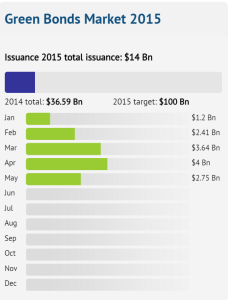This is the first of a two-part column on green bonds. The second installment will include interviews with Axa, QBE and Zurich.
Ahead the United Nations Climate Change Conference in Paris in December, also called COP21 or CMP11, there are those who expect to see a wave of green bond action – and this action may include a good deal of buy-in from the insurance industry.
No definitive reasons are being given for this anticipation. But there is a great deal of hearsay and indications from would-be entrants into the market, according to experts involved in the green bonds game.
Total issuance for the green bonds market for 2015 is just above $14 billion. That’s not quite half 2014’s $36.59 billion total, according to U.K.-based the Climate Bonds Initiative.
However, the head of the group believes the market will grow dramatically in the last seven months of the year, and he thinks it could still reach earlier estimates given by various sources that had the year’s total coming in between $80 billion and $100 billion.
“We still think we’ll get to $80 billion and we think there’s chance will get to $100 billion,” said CEO Sean Kidney.

Kidney has heard of significant investments set to come in from “new corners” of the world, such as India and China, ahead of the Paris summit. He also believes a backlog of green bond investments is waiting to emerge this year from a steady U.K. pipeline.
“We think there’s a big pile of up bonds in the underwriting pipelines,” Kidney said.
He didn’t name any names.
According to Heike Reichelt, head of investor relations and new products at green bond giant the World Bank, public awareness and interest in green bonds is growing, which is helping the market, and that interest could end up making green bonds an important part of the conference.
Among the goals at the global conference is how to achieve the aim of keeping global warming below 2 degrees Celsius, and many people see green bond investing as a key ingredient in any plans going forward.
“Regardless of issuance volumes and those specific developments, a valuable contribution of the green bond market is raising awareness for climate finance opportunities and catalyzing the evolution of sustainable and responsible fixed income capital markets,” Reichelt said. “That has continued. And it is one piece of the puzzle that will hopefully help contribute to a promising outcome later this year at the big global gathering in Paris in December 2015.”
Reichelt said that while it’s still unknown how big this year’s green market will turn out to be, there is one trend she believes proves out the growing interest in green bonds.
“It’s more the diversity of issuers that’s going to be interesting,” she said, explaining that diversity means more sectors of the economy and society are warming to green bonds.
She added: “There are more and more insurance companies that are buying green bonds.”
At one point last year one-fifth the investors on the World Bank’s two biggest green bonds were comprised of insurers.
The World Banks’ list of recent investors in green bonds include: QBE Insurance Group Ltd.; Caisse Centrale de Reassurance; Zurich Insurance; and LF Liv.
Axa SA Chief Executive Officer Henri de Castries told Bloomberg Television in late-May that he’s working to sell 500 million euros ($562.13 million) of coal assets and triple green investments to 3 billion euros ($3.37 billion) by 2020.
Kidney, whose group recently released a guide to green bond investing in China, said he expects much of the investing over the next six months to come from areas outside of the U.S, where there continues to be “weak corporate issuance.”
He and others blame the lag in the U.S. on the fact that the phrase “climate change” remains a political hot potato, as skeptics wage a war against believers and vice versa.
Ceres, a nonprofit group that advocates for sustainability leadership, would like to see U.S. investment in green bonds pick up.
Cynthia McHale, director of the Ceres insurance program, was asked how to get more U.S. insurers interested in green bond investing.
“My quick response is that U.S. insurers have not yet stepped up and it’s worth drawing attention to this,” McHale said.
Like Kidney, she believes that shortfall domestically will continue to be made up for by green bond investing abroad. McHale said she’s heard there is a lot of interest being expressed by U.K. insurers, and she anticipates that several companies will soon be coming out with announcements regarding their green bond plans.
Past columns:
Was this article valuable?
Here are more articles you may enjoy.



 Experian: AI Agents Could Overtake Human Error as Major Cause of Data Breaches
Experian: AI Agents Could Overtake Human Error as Major Cause of Data Breaches  SIAA Announces Strategic Partnership With Progressive
SIAA Announces Strategic Partnership With Progressive  MAPFRE Accuses AAA of Violating Long-Time Exclusive Marketing Agreement
MAPFRE Accuses AAA of Violating Long-Time Exclusive Marketing Agreement  Georgia Republicans Move to Scrap State Income Tax by 2032 Despite Concerns
Georgia Republicans Move to Scrap State Income Tax by 2032 Despite Concerns 

